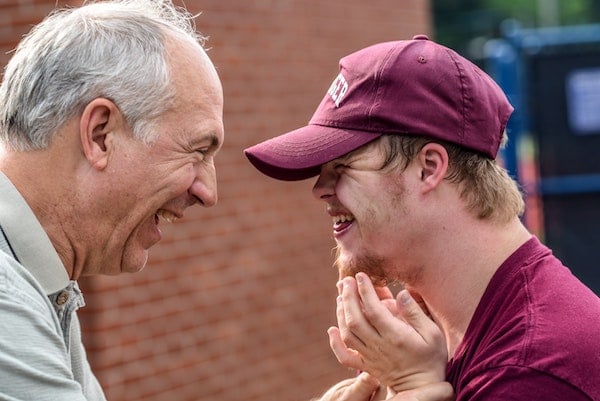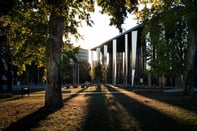Published on
Intergenerational Learning in Higher Education

With the traditional learner demographic changes, attention needs to be shifted to those who need it: older adults. How do institutions make the shift to serve these learners? Tom Meuser, Marilyn Gugliucci and Shirley Weaver discuss intergenerational learning, the challenges of serving both young and older learners, and how it impacts higher education.
The EvoLLLution (Evo): What is intergenerational learning?
Tom Meuser (TM): It’s the open and free exchange of perspectives, values and ideas between individuals and groups with different life experiences. It’s intergenerational in the sense of age difference in this case, and part of the benefit of this cross-generational learning is that one person’s lived experience is another person’s history. An example would be 9/11–most of today’s undergraduates and even graduate students have no living memory of that time. And yet for me, that’s a very present thing, so in an intergenerational exchange, I can give them a sense of what that was like from my own lived experience. That’s something I can provide to that next generation.
Marilyn Gugliucci (MG): That’s really the critical part of intergenerational learning. Skills, values and ideas can’t be stressed enough with the fast pace of what’s happening in technology and in our environment. We’ve become ahistorical in many ways.
One of the projects that we’re running right now is connecting our students with older adults in the community, and having them pay the elders six visits over 18 months. We start off with a life history review and ensure it’s neutral–that both the adults and the students share their experiences, no matter how old they are. The feedback we’ve received is fantastic! Students are excited when they’ve had the chance to sit down with these older adults, just chatting and getting to know each other.
Shirley Weaver (SW): The flip side of that is that we, as older adults, get tuned into modern ways of looking at things, dressing and behaving. Even if we have grandkids, it doesn’t necessarily click until you see and hear it from these professional students– that’s so different to us. We can be just as ageist as the young people can, and it’s really helpful to hear perspectives from both sides of the discussion.
Evo: Could you briefly describe what an age-friendly university designation means?
MG: We turned out to be the fifth university in the US to get this designation and the eleventh worldwide. Now, there are over 65 universities across the globe that have this age-friendly designation and the number’s growing all the time. Essentially, what happens with an age-friendly university is that the university is duty-bound to the contributions of older adults, to bringing them into our classrooms, embracing opportunities to support aging in a positive and healthy way, and having older adults participate in our research.
There’s a give and take between older adults and the generations that we traditionally have within our colleges and universities to try and bring those two groups together to enhance learning for all. Ironically, there are ten guiding principles for this, and the principle we have not yet attained is how well we work with our retired faculty and administrators. We still need to work on that area, but there are facility management issues that come with this, but also academic opportunities.
TM: It’s an evolution. An institution that identifies itself as age-friendly, whether officially or unofficially, does it partially to be aspirational. We recognize the value of intergenerational exchange. We recognize that the learning, culture, communication and teaching structures of a university should cover all interested people. Sometimes, it’s a challenge to include everyone with respect to changes in technology, but there are ways to work around it. At my prior institution I managed a program through which we placed older adults from our community in undergraduate classrooms. We had to do some flexing and bending, with the intent of applying to become age-friendly.
It takes a certain type of place and culture, and that’s one of the things I appreciate most about UNE. We have that welcoming and flexible culture. In our new aging center, there is a group of older adults in our greater community who support our research by volunteering for studies. They provide annual data about their health and wellness but also join in the university’s cultural life.
Our Legacy Scholars Program is a component of our age-friendly identity. It’s helping push the envelope with the innovative work that Marilyn and her team are doing in nursing homes, hospices and in training medical students. Our aging center is university-wide, and there are still a lot of places within the institution that we haven’t touched and need to over time. So, it’s important to recognize that being age-friendly is always a work in progress.
Evo: What are some challenges institutions can face when it comes to serving their older adult learners and providing a space and experience that meets their needs?
TM: It’s important to listen to what the older adults’ goals and wants are. It’s not to just about creating a program and offering it. It’s about listening first and joining these older adult learners in making the experience something that’s meaningful for them. There’s a term we use in gerontology called generativity. It’s where we reach a point in life where we want to give back and make a difference–to leave a living legacy to younger folks in the world. That’s a motivator for many of our legacy scholars to join in intergenerational learning.
We had a program that was an effort to link graduate students at our Portland campus with older adults from the Legacy Scholars’ Program to discuss climate change and its effects on health and aging. Unfortunately, we had to cancel it because of COVID-19, but hopefully we can reboot it. The intent there was to create another intergenerational exchange. I see generational rifts forming around blaming one another for global issues and around other topics. So, the first thing needed is to create a milieu that both groups feel comfortable with and fully own to some extent. The second part is to listen to what older adults want with respect to the learning.
The last piece has to do with the online technology–whether the learning management system is adaptable to an older adult learner and whether they have the technology at home to use it. It means bending and creating new approaches within the current structure to meet those needs.
MG: This is major work that’s coming out of Tom’s Center for Excellence in Aging and Health at UNE. It advocates ensuring a regular dialogue with organizations representing the interests of the aging population. That connection with organizations that are serving or working on behalf of older adults is incredibly important to understanding the values and skills of working with older adults.
In our medical programs, the Geriatric Education Mentors (GEM) programs, we have about 165 older adults who we pair with our medical students. What’s challenging is recognizing the range of educational needs that older adults can have. Some left school early, never finishing elementary or high school. Some have PhDs in their field. To be able to provide information that meets that broad range of socioeconomic and education training is a challenge. This is definitely an evolving process. Intergenerational learning is very complex, not only because of a range of personalities but because of a range experiences across the years.
SW: We always have to keep in mind in a health profession program that older adults love to volunteer. They want to be helpful. Involvement adds to their quality of their life. The trick for us is we haven’t given them enough guidance about the range of authority they have in giving feedback to students and engaging them from a learning point of view. Many students go to our volunteers for help practicing assessments. When we started to talk to them, volunteers said they’d be happy to do more if they only had some guidelines. You have to think about educating the faculty on how to work with these older adults and engage them.
MG: We have first-year students going out and doing blood pressure tests on the older adult GEMs they work with. We’ve set up training for the older adult to know exactly how a proper blood pressure is taken. We encourage the GEM to respond to students and even test them a little bit. We’re educating them, which in essence is helping them be more informed about their own health as well as helping medical students become better practitioners.
Evo: What outcomes do we hope for in our learning environments where we bring together older adults with younger adults?
TM: Intergenerational learning and exchange shouldn’t be forced. The best intergenerational learning happens naturally and incidentally in personal interactions between individuals of different age groups and perspectives. The primary outcome that I care about is that everyone is harnessing special and particular knowledge that each group may have. If we can say somebody has walked out of an experience with a new perspective, that’s what matters.
MG: Shirley and I had the opportunity to conduct research across the state of Maine for its last state plan on aging. In talking with older adults, one of the major components that continues to come up is that older adults don’t want to be around people their own age. They want that intergenerational connection and sharing because it makes them feel more alive and allows them to share their experiences and learning with younger adults.
You have these environments, such as nursing homes, assisted living or continuing care retirement communities where older adults are gathered, and those are prime areas to reach out to connect students to that environment, or you can invite older adults to the university and engage them in any of its cultural, arts or humanities functions.
Evo: How can intergenerational program composition improve enrollment rates and learning outcomes?
TM: There’s a movement or motivation in higher education right now to look to non-traditional learner groups, as our traditional population is becoming smaller than classroom capacities at most institutions. The benefits of intergenerational learning should not be attached to revenue generation for an institution. That’s a recipe for disaster.
Institutions like ours that have a track record for engaging and working within its community are in a good place to create bridges to support engagement within the classroom. You could think about enrollment from the perspective of what attracts students to a particular institution. In terms of supporting enrollment and sustainability, an intergenerational milieu speaks well of the learning environment and its potential. It’s logical for the health professions to be involved because they work directly with older adults anyway. That’s just the reality of things. Hopefully students can see and take this opportunity to learn from persons of different ages. In terms of enrollment, it’s not going to make money with and from seniors. It’s integrating them into the environment or milieu that attracts students to the institution.
MG: Around 2034, the number of children is projected to decrease to the point where there are going to be more older adults than younger people. This is the first time in history that this is occurring. Many of our older adults with better health and education are having extending their careers or changing them entirely, and colleges and universities certainly play a role in educating and training them to get started. It’s not uncommon to hear about older adults getting, bachelor’s, master’s degrees or doctorates into their 70s or 80s. Our colleges and universities can certainly enhance the education and wellbeing of older adults through education.
There’s a palpable excitement in the classes with both younger and older students. Colleges and universities are in a prime position to think more broadly. This age-friendly university initiative is growing. I hope it continues, and there are myriad indications that it will.
Author Perspective: Administrator



